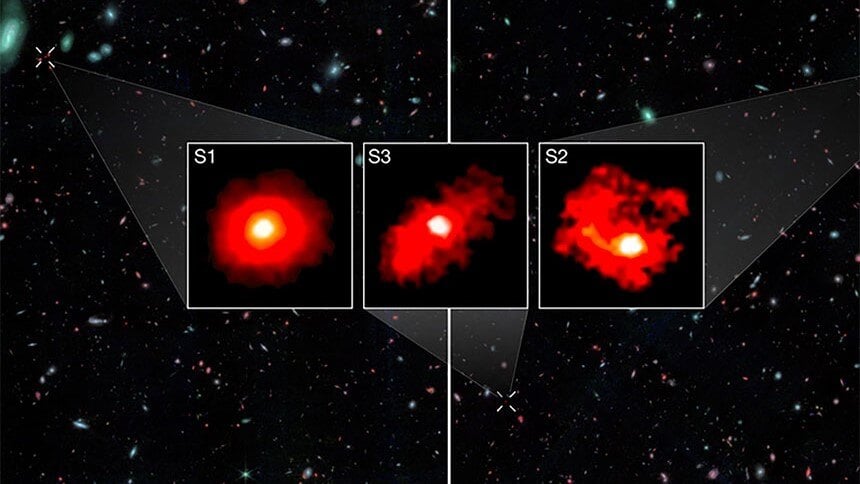An international team including researchers from the University of Valencia has identified 36 massive galaxies — three of which are ultra-massive red monsters — that are part of the early universe and are obscured by their own interstellar dust. This finding, published in Nature, highlights a cosmological efficiency that challenges existing galaxy formation models and marks a cosmological milestone, made possible by the James Webb Space Telescope (JWST), the most sensitive and precise space-based observatory to date
Over the last decade, observations at millimetre and mid-infrared wavelengths, capable of revealing dense regions of gas and dust surrounding the most intense star-forming regions, have unveiled a substantial population of optically dark massive galaxies. They are so called because they cannot be detected using optical wavelengths. As a result, the primary physical characteristics of these galaxies — such as their stellar mass or the number of stars they contain — have remained uncertain. Since NASA and its partners — the European Space Agency (ESA) and the Canadian Space Agency (CSA) — launched the James Webb, the world’s most powerful space observatory, into space in 2021, the advancements in this field represent a true cosmological milestone.
An international study, including participation from the University of Valencia, has just revealed an abundance of massive galaxies — 36 in total — obscured by their own interstellar dust and identified spectroscopically, that is, by examining spectral lines created by the most abundant chemical elements — hydrogen and oxygen — in the distant universe.
In particular, this study led by the University of Geneva (UNIGE) and recently published in Nature indicates that three of these galaxies contain up to 100 billion stars. They are ultra-massive galaxies, almost as massive as the Milky Way, and, as noted in the article, the fact that they were found in such a small area of the sky suggests that they may have existed in significant quantities as early as one billion years after the Big Bang. This finding supports the hypothesis that galaxies in the early universe formed their stars much more efficiently than previously thought.
"Thanks to the unprecedented sensitivity of the James Webb, these galaxies were identified immediately", commented Mauro Stefanon, CIDEGENT researcher in the Astronomical Observatory of the University of Valencia, located at the Science Park, and co-author of the article. "The spectroscopic confirmation of these galaxies not only verifies their existence during these epochs but also allows us to measure their stellar masses with high confidence. The combination of the large number of galaxies identified in a very small area of the sky and their high stellar masses indicates that roughly half of the gas contained within them has been converted into new stars. This is a very high ratio, suggesting such extremely efficient star formation during that era that it challenges current cosmological models", Stefanon explains.
These are not the first massive galaxies from the early universe observed by the James Webb. In 2022, another team of scientists identified four galaxies that probably merged from gas around 350 million years after the Big Bang, the oldest ever detected. Last year, a project involving the University of Valencia identified a population of six galaxies observed in a period between 500 and 800 million years after the formation of the universe.
“In addition to their elevated masses, the observations indicate that these galaxies are forming stars very intensively, at a rate of between 600 and 1,000 new stars each year. This is a star formation rate that corresponds to about 20% of the total cosmic star formation rate and occurs within the first billion years of the universe's history. All this, which we now see, was hidden behind dust", explains the scientist.
This surprising discovery was made possible thanks to the James Webb Space Telescope's FRESCO programme, which uses the NIRCam/grism spectrograph to accurately measure the distances and stellar masses of galaxies.
Discovery of 'red monsters'
Upon analysing the galaxies from the FRESCO survey, researchers confirmed that the three ultra-massive galaxies identified — dubbed 'the three red monsters' due to their appearance in JWST images given by their high dust content — are forming stars almost twice as efficiently as their lower-mass counterparts and galaxies from later epochs.
Although these findings do not contradict the standard cosmological model, they do raise new questions about existing theories on galaxy formation. As the article suggests, current models may need to consider unique processes that enabled certain early massive galaxies to achieve such efficient star formation and, consequently, to form very quickly and at such an early epoch in the universe. Future observations with JWST and the Atacama Large Millimeter Array (ALMA) will provide further insights into these ultra-massive red monsters and reveal larger samples of this type of source. "As we study these galaxies further, new perspectives will emerge on the conditions that shaped the universe’s earliest eras. The red monsters are just the beginning of a new era in the exploration of the early universe," concludes Mengyuan Xiao, UNIGE researcher and lead author of the study.
Massive Optically Dark Galaxies Unveiled by JWST Challenge Galaxy Formation Models. Mengyuan Xiao, Pascal Oesch, David Elbaz, L. Bing, Erica Nelson, Andrea Weibel, G. Illingworth, Pieter van Dokkum, Rohan Naidu, Emanuele Daddi, Rychard Bouwens, Jorryt Matthee, Stijn Wuyts, John Chisholm, Gabriel Brammer, Mark Dickinson, Benjamin Magnelli, Lucas Leroy, Daniel Schaerer, Thomas Herard-Demanche, Seunghwan Lim, Laia Barrufet, Ryan Endsley, Yoshinobu Fudamoto, Carlos Gómez-Guijarro, Rashmi Gottumukkala, Ivo Labbe, Daniel Magee, Danilo Marchesini, Michael Maseda, Yuxiang Qin, Naveen Reddy, Alice Shapley, Irene Shivaei, Marko Shuntov, Mauro Stefanon, Katherine Whitaker, J. Stuart Wyithe. Nature.
Recent Posts


